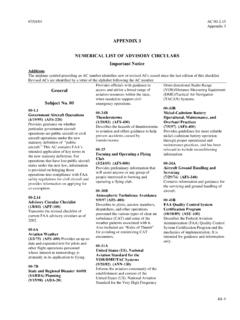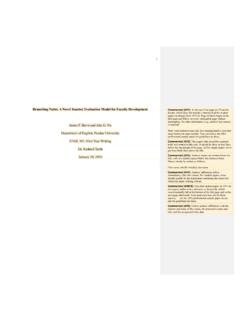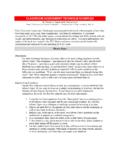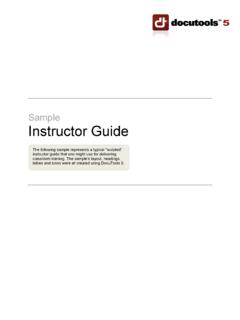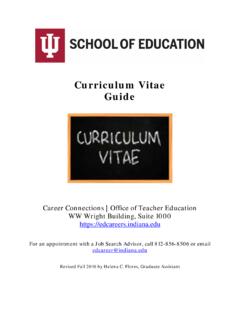Transcription of Certificated Flight Instructor Preparation Guide
1 Contents PageSection 1 - General 1-1 Introduction 1-1 The Players 1-1 The Student 1-1 The Student's Instructor 1-1 The FAA Inspector 1-2 The CFI PTS 1-2 The Practical Test 1-3 Reference Material 1-4 Preparing for the Practical Test 1-6 The Flying Portion of the Practical Test 1-8 Flow to Use This Guide 1-9 Step 1 1-9 Step 2 1-10 Step 3 1-10 Section 2 - Area of Operation I, Fundamentals of Instructing 2-1I. Fundamentals of Instructing 2-4A. The Learning Process 2-4B. Human Behavior and Effective Communication 2-6C. The Teaching Process 2-8D. Teaching Methods 2-10E. Critique and Evaluation 2-12F. Flight Instructor Characteristics and Responsibilities 2-14G. Planning Instructional Activity 2-17 Section 3 - Areas of Operation II and III, Technical Subject 3-1 Areas and Preflight PreparationII. Technical Subject Areas 3-3A. Aeromedical Factors 3-3B. Visual Scanning and Collision Avoidance 3-6C. Principles of Flight 3-9D. Airplane Flight Controls 3-12E. Airplane Weight and Balance 3-13F.
2 Navigation and Flight Planning 3-16G. Night Operations 3-20H. High Altitude Operations 3-24I. Federal Aviation Regulations and Publications 3-26J. National Airspace System 3-28K. Navigation Systems and Radar Services 3-31L. Logbook Entries and Certificate Endorsements 3-32 III. Preflight Preparation 3-36A. Certificates and Documents 3-36B. Weather Information 3-39C. Operation of Systems 3-42D. Performance and Limitations 3-44E. Airworthiness Requirements 3-46 ContentsPageSection 4 - Area of Operation IV, Preflight Lesson on a Maneuver 4-1 to be Performed in FlightIV. Preflight Lesson on a Maneuver to be Performed in Flight 4-1A. Sample Whiteboard 4-2A. Sample Lesson Plan 4-3 Section 5 - Areas of Operation V through XIII, Maneuvers 5-1V. Preflight Procedures 5-4A. Preflight Inspection 5-4B. Single-Pilot Crew Resource Management 5-7C. Engine Starting 5-9D. Taxiing - Landplane 5-12G. Before Takeoff Check 5-15VI. Airport Operations 5-19A. Radio Communications and ATC Light Signals 5-19B.
3 Traffic Patterns 5-21C. Airport, Runway and Taxiway Signs, Markings, and Lighting 5-26 VII. Takeoffs, Landings, and Go-Arounds 5-28A. Normal and Crosswind Takeoff and Climb 5-30B. Short-Field Takeoff and Maximum Performance Climb 5-33C. Soft-Field Takeoff and Climb 5-36F. Normal and Crosswind Approach and Landing 5-42G. Slip to a Landing 5-46H. Go-Around/Rejected Landing 5-49I. Short-Field Approach and Landing 5-49J. Soft-Field Approach and Landing 5-55K. Power-Off 180 Accuracy Approach and Landing 5-55 VIII. Fundamentals of Flight 5-63A. Straight-and-Level Flight 5-69B. Level Turns 5-71C. Straight Climbs and Climbing Turns 5-74D. Straight Descents and Descending Turns 5-77IX. Performance Maneuvers 5-80A. Steep Turns 5-80B. Steep Spirals 5-83C. Chandelles 5-86D. Lazy Eights 5-88X. Ground Reference Maneuvers 5-90A. Rectangular Course 5-92B. S-Turns Across a Road 5-95C. Turns Around a Point 5-98D. Eights on Pylons 5-102 Contents PageXI. Slow Flight , Stalls, and Spins 5-106A.
4 Maneuvering During Slow Flight 5-109B. Power-On Stalls 5-112C. Power-Off Stalls 5-115D. Crossed-Control Stalls 5-118E. Elevator Trim Stalls 5-122F. Secondary Stalls 5-124G. Spins 5-126H. Accelerated Maneuver Stalls 5-128 XII. Basic Instrument Maneuvers 5-130A. Straight-and-Level Flight 5-134B. Constant Airspeed Climbs 5-136C. Constant Airspeed Descents 5-139D. Turns to Headings 5-141E. Recovery from Unusual Flight Attitudes 5-143 XIII. Emergency Operations 5-145A. Emergency Approach and Landing 5-146B. Systems and Equipment Malfunctions 5-150C. Emergency Equipment and Survival Gear 5-152D. Emergency Descent 5-153 XIV. Postflight Procedures 5-155A. Postflight Procedures 5-155 Appendix 1. An Example of the First Three Pages, the Task, A 1-1 Strategy, and Reference Materials List Appendix 2. Reference Documents for Fundamentals of Instructing A 2-1 Appendix 3. Reference Material - Logbook Entries and Certificate A-3-1 EndorsementsAppendix 4. Mini Lessons/Special Topics A 4-1 Appendix 5.
5 Flight Check Timetable A 5-1 Appendix 6. Tracking Checklist 16-1 Section 1 GeneralIntroductionThis Guide has been designed to assist anyone involved in Flight Instructor training. It can be used by a perspective applicant preparing for the Flight Instructor certificate. It can be used by the Flight Instructor preparing a prospective Flight Instructor . It is my hope it will be used by FAA Inspectors testing a Flight Instructor idea for this Guide has been floating around in my head for some time. After retiring from the FAA, with just short of 30 years as an Operations Inspector, I decided to teach part-time. My agreement with the owner of the school where I teach is that I could focus my efforts on Flight Instructor students. Between my experience as an Inspector, giving Initial Flight Instructor Flight checks and working with students, it became increasingly obvious that there just wasn't any real hands-on guidance designed to prepare the Flight Instructor more I work with students, the more I find a disconnect between the task of preparing a would-be Flight Instructor and what the Certificated Flight Instructor (CFI) Practical Test Standards (PTS) is all this Guide also became important to me on a more personal basis, as I realized how far too many of my fellow FAA Inspectors failed to understand the intent of the PTS and how their application of it was inconsistent.
6 In retrospect, that statement is probably an analysis of my own Flight Instructor checkrides as an of preparing a Flight Instructor Student includes making sure that they understand what takes place, who the folks are that they will meet and work with, what they do and do not need to learn, and where they fit into the puzzle. I have also tried to explain how the PTS works and what to expect in the Practical Test. The PlayersPreparing a would-be Flight Instructor is like a three-legged stool. There is a student, there is the student's Instructor and there is the Inspector. If any of the legs isn't holding up its part of the stool, the stool tips Student (aka, the CFI Student, the CFI applicant, the applicant)Let s start with the central figure, the student seeking a Flight Instructor certificate. He is usually under 25 and has around 250 hours total Flight time. His goal isn't usually to become a career Flight Instructor , it's to gain hours and experience to move up in the aviation world.
7 Up until the day the student starts training to become a Certificated Flight Instructor ; he has only been a student learning to fly. With 250 hours a student is like a sponge, with a very limited base of experience but eager to learn. In the role of a "student" he has typically been a receiver of information, far too often taking what he is taught as gospel. This is not a criticism; it is an observation. Once he becomes a Flight Instructor , the roles change; he becomes a dispenser of information and a recipient of "Why?" Student's InstructorTo begin with, this guy has to have 200 hours as an Instructor and has to have been a CFI for at least two years. That makes him a really old guy. Beyond his age and experience he is hard to describe. In my case I am retired, wanting to1-1give back something to flying. The fellow I work with is the owner of a Flight school and a Designated Pilot Examiner. He is over 60. Most everyone that teaches Flight Instructor students has been around for a while.
8 That experience is what is necessary to help the student learn how to answer the "Why?" FAA InspectorThe FAA Inspector is usually seen as the bad guy, the obstruction, agd the gate through which all CFI applicants have to pass on their way to their fact FAA Inspectors are human beings and put their pants on one leg at a time, just like everyone else. With very few exceptions, FAA Inspectors do not get a thrill when they fail CFI applicants. In reality they are just as frustrated as anyone when they get an ill-prepared applicant, and they get far too many of Inspectors receive little or no formal training regarding the use of the Flight Instructor PTS. That does not diminish their basic skills; it means they are doing the best they can with what they have. It also means they interpret the PTS from their own individual perspective. This is what contributes to Inspectors are generally over-worked and spread too thin. A General Aviation Operations Inspector must have a working knowledge of about two dozen regulations, a new Handbook that has been described as over a foot thick, as well as tons of other guidance material.
9 They are also responsible for hundreds of skill sets including accident investigation, legal enforcement, airline/operator certification, Designated Pilot Examiner oversight, airshow surveillance, 709 re-examinations, and medical Flight checks, among Instructor certification is but a small part of an inspector's CFI PTSThe CFI PTS is the bible when it comes to CFI training and testing. Reading and understanding it should be the first thing anyone wanting to get their CFI should do. It should be in the student's hands whenever receiving training or practicing CFI PTS as published by the Department of Transportation, Federal Aviation, Airman Testing Standards Branch, AFS-630 is divided into three major parts: The first part is the Introduction, which is general in nature and explains howto use the PTS. (Everything from the Cover Page through the ContentsPages) The second part is titled, SECTION 1, Flight Instructor AIRPLANE-SINGLE-ENGINE, Practical Test Standards. It describes all of the Areas ofOperations, Tasks and Elements for Airplanes with one The third part is titled, SECTION 2, Flight Instructor AIRPLANE- MULTIENGINE, Practical Test Standards.
10 It describes all of the Areas of Operations, Tasks and Elements for Airplanes with two or more 1 defines how single-engine practical tests are to be conducted. It establishes the Areas of Operation and Tasks. It also describes the Elements within the Tasks, and it establishes the standards of performance. It also has a list of all of the references used in its development and our purposes we will only be concerned with the first two parts of the CFI PTS is the one document that the Student, the Student's Instructor and the FAA Inspector must follow when conducting the Practical function of the PTS is to define the regulatory nature of the Flight Instructor Practical Test. The only "standards" of acceptable performance are those listed in the PTS. The success or failure of any given task must be judged solely by the standards of the particular Practical TestCertificated Flight Instructor applicants have a horrible failure record. Actually, their failure rate is remarkable; it's their pass record that is horrible.

